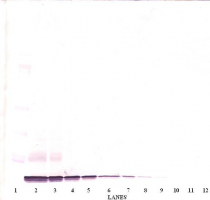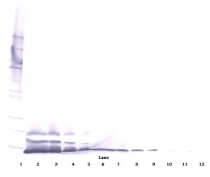ARG66104
anti-CXCL14 antibody
anti-CXCL14 antibody for ELISA,IHC-Formalin-fixed paraffin-embedded sections,Western blot and Human
Overview
| Product Description | Rabbit Polyclonal antibody recognizes CXCL14 |
|---|---|
| Tested Reactivity | Hu |
| Tested Application | ELISA, IHC-P, WB |
| Host | Rabbit |
| Clonality | Polyclonal |
| Isotype | IgG |
| Target Name | CXCL14 |
| Antigen Species | Human |
| Immunogen | E. coli derived recombinant Human CXCL14. (SKCKCSRKGP KIRYSDVKKL EMKPKYPHCE EKMVIITTKS VSRYRGQEHC LHPKLQSTKR FIKWYNAWNE KRRVYEE) |
| Conjugation | Un-conjugated |
| Alternate Names | MIP-2G; KS1; BMAC; Small-inducible cytokine B14; KEC; C-X-C motif chemokine 14; MIP-2g; Chemokine BRAK; MIP2G; BRAK; NJAC; SCYB14 |
Application Instructions
| Application Suggestion |
|
||||||||
|---|---|---|---|---|---|---|---|---|---|
| Application Note | IHC-P: Antigen Retrieval: Boil tissue section in Sodium Citrate buffer (pH 6.0) followed by cooling at RT for 20 min. * The dilutions indicate recommended starting dilutions and the optimal dilutions or concentrations should be determined by the scientist. |
Properties
| Form | Liquid |
|---|---|
| Purification | Affinity purification with immunogen. |
| Buffer | PBS (pH 7.2) |
| Concentration | 1 mg/ml |
| Storage Instruction | For continuous use, store undiluted antibody at 2-8°C for up to a week. For long-term storage, aliquot and store at -20°C or below. Storage in frost free freezers is not recommended. Avoid repeated freeze/thaw cycles. Suggest spin the vial prior to opening. The antibody solution should be gently mixed before use. |
| Note | For laboratory research only, not for drug, diagnostic or other use. |
Bioinformation
| Database Links | |
|---|---|
| Gene Symbol | CXCL14 |
| Gene Full Name | chemokine (C-X-C motif) ligand 14 |
| Background | This antimicrobial gene belongs to the cytokine gene family which encode secreted proteins involved in immunoregulatory and inflammatory processes. The protein encoded by this gene is structurally related to the CXC (Cys-X-Cys) subfamily of cytokines. Members of this subfamily are characterized by two cysteines separated by a single amino acid. This cytokine displays chemotactic activity for monocytes but not for lymphocytes, dendritic cells, neutrophils or macrophages. It has been implicated that this cytokine is involved in the homeostasis of monocyte-derived macrophages rather than in inflammation. [provided by RefSeq, Sep 2014] |
| Function | Potent chemoattractant for neutrophils, and weaker for dendritic cells. Not chemotactic for T-cells, B-cells, monocytes, natural killer cells or granulocytes. Does not inhibit proliferation of myeloid progenitors in colony formation assays. [UniProt] |
| Calculated MW | 13 kDa |
| PTM | Ubiquitinated, followed by degradation by the proteasome. |
Images (4) Click the Picture to Zoom In
-
ARG66104 anti-CXCL14 antibody IHC-P image
Immunohistochemistry: Formalin-fixed and paraffin-embedded sections of Human breast invasive ductal carcinoma. The recommended ARG66104 anti-CXCL14 antibody concentration is 0.25 µg/ml with an overnight incubation at 4°C. An HRP-labeled polymer detection system was used with a DAB chromogen. Antigen Retrieval: Boil tissue section in Sodium Citrate buffer (pH 6.0) followed by cooling at RT for 20 min.
-
ARG66104 anti-CXCL14 antibody WB image
Western blot: 250 - 0.24 ng of Human BRAK stained with ARG66104 anti-CXCL14 antibody, under non-reducing conditions.
-
ARG66104 anti-CXCL14 antibody standard curve image
Sandwich ELISA: ARG66104 anti-CXCL14 antibody as a capture antibody at 0.5 - 2.0 µg/ml combined with ARG66105 anti-CXCL14 antibody (Biotin) as a detection antibody. Results of a typical standard run with optical density reading at 405 - 650 nm.
-
ARG66104 anti-CXCL14 antibody WB image
Western blot: 250 - 0.24 ng of Human BRAK stained with ARG66104 anti-CXCL14 antibody, under reducing conditions.









